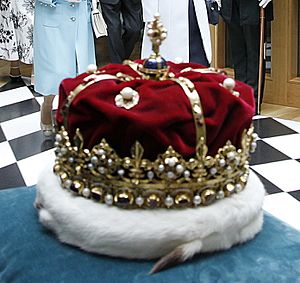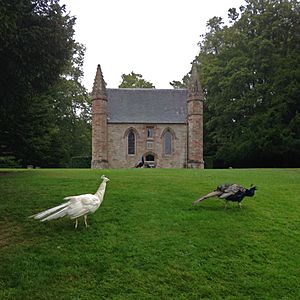Scottish coronation of Charles II facts for kids

Gold 1651 coronation medal
|
|
| Date | 1 January 1651 |
|---|---|
| Location | Scone Palace, Perth, Scotland |
| Participants | |

King Charles II (born 1630, died 1685) became King of Scotland on January 1, 1651. This important event took place at Scone Palace. His father, King Charles I, had been executed in London in 1649. Charles II arrived in Scotland in June 1650. Many people in Scotland supported him after a special agreement called the Treaty of Breda.
Charles stayed at an old house in Perth called Gowrie House. He held meetings there by the River Tay. Special medals were made to celebrate his coronation. These were called "coronation pieces." Just before the coronation, on Christmas Day 1650, an old document was found. It was signed by Robert the Bruce in 1326. This document said that the Stuart dynasty should always be the rulers of Scotland.
Contents
The Coronation Ceremony

Charles traveled to Scone Palace on December 31. The next day, he put on a special prince's robe. He sat under a fancy canopy in the palace hall. Then, a procession walked to the nearby chapel at Moot Hill.
Key Moments of the Coronation
During the ceremony, the Honours of Scotland were placed on a table next to Charles. These are the Scottish crown, sword, and scepter. A minister named Robert Douglas gave a long sermon. He spoke about how the new king must respect the Presbyterian faith. He also said the king must follow the Covenantal cause.
Charles then made his coronation oath. He promised to support the National Covenant and the Solemn League and Covenant. After this, he sat on a throne on a raised platform.
Who Crowned Charles II?
John Campbell, 1st Earl of Loudoun, who was the Lord Chancellor of Scotland, crowned Charles. He was helped by Archibald Campbell, Marquess of Argyll. Other important people also helped. Alexander Montgomery, Earl of Eglinton, John Leslie, Duke of Rothes, and John Lindsay, Earl of Crawford and Lindsay carried the sword and scepter.
After being crowned, Charles was announced as the King of Scotland, England, France, and Ireland.
After the Crowning
It was a tradition for the king's family history to be read aloud. James Balfour, who was the Lord Lyon King of Arms, read Charles's family line all the way back to King Fergus.
After the ceremonies in the chapel, everyone went to the palace for a big banquet. The next day, Charles made some local landowners from Perthshire into knights. Then, he returned to Perth.
Coronation Feast and Costs
Even though this coronation happened during a difficult time, there was a lot of money spent. Especially on food for the banquet! They had salmon, calves' heads, and partridges. They also had fancy wines from Bordeaux and Burgundy. A lot of sugar was bought, and some of it was dyed red with cochineal.
Some of the costs were paid by James Murray, the owner of Scone Palace. The king's official household also helped pay. They bought torches in Perth. A laundress named Mary Durham made many napkins for the king's table and the lords' table. Some napkins even had the king's initials, "CR," sewn onto them.
|

